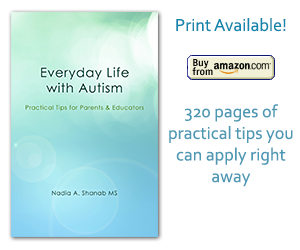What Causes Autism? From Morgan Autism Center Conference
Nadia Shanab | autism13 Nov 2013
This is a summary of one of the sessions that I have attended at the Morgan Autism Center last September. The speaker, Jill Escher, narrates her own story of struggle and discoveries. She has 2 kids with “idiopathisc autism”.
It is a very informative and eye-opening story that all parents should read. What causes autism is believed to be an environmental epigenetic interaction.
What Causes Autism
How parents and caregivers can help solve the mysteries of the autism epidemic
Over the last 25 years autism has increased 25 folds.
Part 1
Why we can have a “genetic epidemic”
- Various disruptions of genome; 1000s of genes are implicated OR disruption of early brain development
- Impaired neurodevelopment (eg, impaired synaptic activity or dendritic proliferation)
- Abnormal phenotypes (or characteristics) appear called “autism spectrum” (eg, nonverbal, poor social cognition)
The Broader Autism Phenotype/Characteristic
- Autism
- Asperger’s
- ADD/ADHD
- Learning disabilities
- Mental illness
- Sensory processing disorder
- Emotional disturbance
- Oppositional defiant disorder
- Obsessive-compulsive disorder, OCD
- Epilepsy
- Intellectual disability (previously: mental retardation)
Autism is just one outward manifestation of underlying, and overlapping, neuro-developmental problems.
The most popular answer to the question: What causes autism? Is usually: “There are two main factors, namely genes and environment that are responsible for autism, besides many other factors.” Another typical answer would be: “A combination of genetic and environmental factors are responsible for autism.”
Do you think that the exposure to pollutions (air, water, etc…), toxins and medicines have affected our genes? You mean: Environmental Epigenetics?
Know that industrial chemicals, cigarette smoke, drugs and pharmaceuticals, nutrition, radiation, military exposures, exercise and stress are all external factors that can destabilize genome, causing mutations, or the way our genes are expressed (epigenetics).
Also, know that kids start as complex molecules (DNA) in their grandmothers’ wombs.
Facts
Environmental exposures can simultaneously affect THREE generations.
In a sense, every mom gives birth to TWO generations at once.
Environmental exposure to:
- Pesticides (DDT)
- Agent Orange (dioxin)
- Plastics
- Flame retardants
- PCBs
- Contraceptive pills,
- Anti-nausea drugs
- Weight loss drugs
Disrupt our delicate hormonal signaling.
Exposures during vulnerable periods of development can cause mutations or epigenetic derangements in germ line manifesting as “inherited” abnormalities in grandkids.
Part 2
Jill Escher, the speaker and presenter of this topic, has narrated her own story as follows.
She was born in 1965 in Los Angeles with normal development. Nobody in her direct or extended family was ever diagnosed with developmental conditions. She had three kids: normal conceptions, pregnancies, deliveries, no unusual exposures, nor genetic anomalies.
However, two of her kids have incapacitating abnormal neurodevelopment, labeled: “idiopathic autism.”
While reading a 2010 study about IVF (In Vitro Fertilization), she started connecting the dots. She called her mother and asked her if she happened to use fertility treatments when she had her. The answer was positive. Her investigations lead her to a huge discovery. Jill dug until she managed to find out the “six” different drugs her mom was treated with during her pregnancy. Googling “Deluteval” – the treatment her mom was administered when she expected her- only one document came up:
Prenatal Exposure to Synthetic Progestins and Estrogens: Effects on Human Development
Seventy-one offspring of mothers administered combinations of synthetic porgestins and estrogen for maintenance of at-risk pregnancy were evaluated for their performance on IQ and personality tests.
Tens of millions of women were exposed to fake hormones or other drugs back in the sixties. These drugs affected the reproduction system in both, males and females. They themselves were born “normal”, but their offspring were not. That explains how the third generation got affected.
Summary
In light of the potential significance of gene-environment interaction, consideration of our ancestral exposures should be included in autism research.
Part 3
How we can help further autism science
- Help kickstart new studies on gene-environment interaction
- Advocate that current studies reach for exposure data from autism families
- Connect autism researchers with experts in toxicology, “exposome” history, epigenetics, and endocrine disruption
- Crowdsource information (“citizen science”)
- Let’s wake up the folks at FDA and EPA
- We must allow all Americans access to their prenatal exposure records
nadia shanab
Tags: asperger's syndrome, autism, chemicals, communication, consequences, diagnosis, drugs, environmental, ferility treatment, genetics, health, IVF, neurodevelopmental conditions, pollution, research, smoking, social interaction, speech, symptoms of autism, toxins
